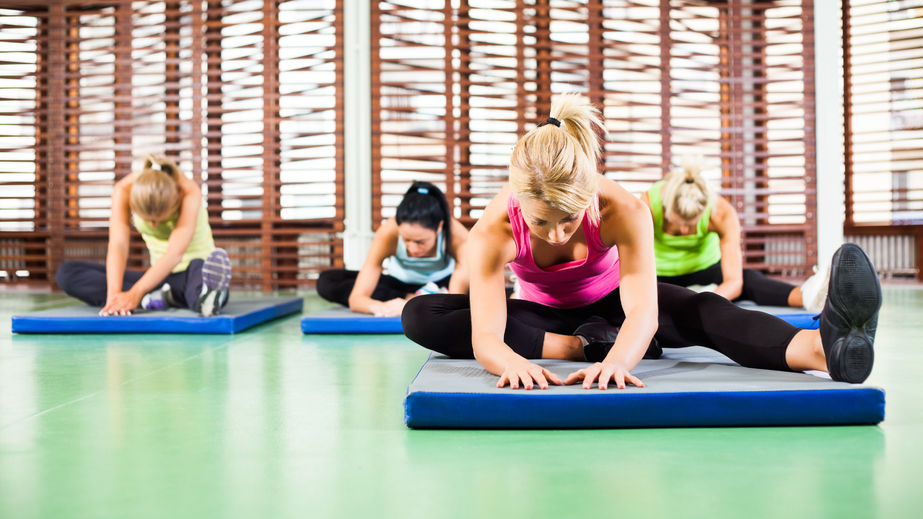Stretch Your Time
#withDavida
You did it! You squeezed your schedule and fit in time to exercise. You made it to that fast aerobic muscle class that seems to make your legs achy-sore for at least a day. Now it’s the end of the class and you keep glancing at the clock trying to decide at which point you can bolt out of the room and skip the boring stretching routine. You’re thinking you can do a lot in that two extra minutes if you can only beat everyone out the door.
Wrong! Unless you’re going to a yoga class next, your two minutes are better spent taking some deep breaths and lengthening the muscles that just carried you through the workout. It gives you a moment to mentally relax and increase oxygen and flexibility for muscles while they’re warm and more malleable.
There’s a lot of research disputing the usefulness of stretching. In the end most find it does not harm or benefit. After 18 years of helping people exercise properly and many more living in my own body I’m in the camp that finds it time well spent. But I’d rather have you do it right and gain whatever reward it offers.
Stretching anything before moving and elevating your body temperature is wrong. The science does support that. Tugging or pulling muscles that are cold and stiff are steps towards injury. Although studies of athletes have not shown it to contribute to injury as it is often cited, athletes have had lesser performance with stretching before. These high performing athletes have found that stretching before activity slightly decreases their sprint time or keeps them from reaching their maximum potential.

The best way to stretch is to warm up first!
Increase your body temperature with light activity ideally using the muscles you’re about to work in your exercise routine. At the end of that 8-10 minute warm-up you might include light dynamic stretches. This is activity that moves the body through a full range of motion while gradually increasing the reach and/or speed in a controlled manner. This is like a warm-up in a proper aerobic conditioning class that includes repetitive moves like squats or lunges. But always remember this is your pre-exercise work and moves that are only designed to get you going.
Personally, I find this makes my body feel looser and my muscles are ready to react better. Many experts believe it could be the placebo effect of following a routine. But it feels good and anything that brings pleasure to exercise is welcome.
The end of the workout is when you want to take the time to hold your stretches. After slowing down and lowering your heart rate go through a routine of stretches targeting the muscles that you just used. I recommend holding a proper stretch 10-20 seconds while breathing deeply. This will help clear lactic acid, a chemical that builds up in the muscle after vigorous activity. Since your muscles are warm you will find it easier to stretch and increase your range of motion. This is good for those tight areas that limit your ability to touch your toes or easily reach for something in the back seat of the car.
Some fitness gurus say post workout stretching is a good way to reduce muscle soreness. Again the scientists say they don’t have evidence of this but if you body likes it, why not? To avoid sore and stiff muscles I recommend more activity and stretches the next day. A hot tub or Epsom salts bath works wonders and a remedy I swear by.
If you also feel stretching useful, below are some of my favorite tips and corrections.
Do not bounce your stretches. Be sure to breath into the movement. If you feel pain stop or lighten up.
Consult your doctor before beginning any type of exercise program or stretch regimen.
Standing Quad Stretch:
Performed by bending a knee and catching the foot in your hand at the butt. I see most people do this wrong as they pull their foot up and are more likely pulling knee ligaments. Instead push your shoelaces into your hand toward the back. That engages the hamstring and stretches the quadriceps muscles.
Lunging Calf Stretch:
This one is also often done wrong. The correct move is to step back with one foot pushing your heel toward the floor while your weight is on the front foot. Make sure your toes are pointing forward as opposed to the corner of the room.
Hip Flexor Stretch:
Most people need to stretch these muscles because they are contracted most of the day especially if you work at a desk. On one knee lunge the other foot forward. Be sure your front knee is over the ankle putting the knee at a 90-degree angle. Slide your back knee behind slightly as you gently press your hip forward.
Low Back Stretch:
Always, always, always do back stretches. As you age gravity is pulling you down and compressing your spine. The easiest is to bend over putting your weight on your thighs and arching your back. I like to drop the belly, take a breath and then arch as I exhale. This is for the lower back. You can also stretch the upper back by lifting the chest slightly higher, extending your arms and crossing you hands then pressing your palms together.
Hamstring Stretch:
The hamstrings are another area that should be stretched often as tight hamstrings can contribute to back and hip pain. A sitting stretch is more effective then standing. Sit and straighten one leg while bending the other with the sole of your foot resting at your inner thigh. Then try to keep the foot of the straight leg pointed up and the spine long as you bring your chest toward the thigh. Repeat on the second leg.
References:
1. http://www.sciencedaily.com/releases/2011/02/110218083422.htm
2. http://www.webmd.com/fitness-exercise/new-ideas-on-proper-stretching-techniques
3. http://journals.lww.com/cjsportsmed/Abstract/2006/05000/Pre_exercise_Stretching_and_Sports_Related.7.aspx (https://pubmed.ncbi.nlm.nih.gov/16778543/)











